Wings for Wildlife: Aviation at Sheldrick Wildlife Trust
The Sheldrick Wildlife Trust, founded in 1977, is a charity focused on the conservation, preservation and protection of wildlife and habitats in Kenya. Their well-written newsletters are always a joy to receive, with news and stories from the trust and if you adopt an orphan elephant, rhino and giraffe, you receive additional content including a monthly update about your chosen animal along with videos and photographs from the Keepers’ Diaries. I have actually adopted the same elephant twice, three-year-old Kinyei, as a gift for two different people, both of whom were happy to tell me all about Kinyei when I asked.
She’s a bit shy and lovely, but does have friends; growing fast. I show her baby picture when all the other people keep showing me pictures of their new grandchildren.
When I saw the most recent newsletter, in which Angela Sheldrick remembers her father patrolling the region in his Super Cub and contrasts it with how aviation supports the Sheldrick Wildlife Trust’s conversation efforts today, I knew I wanted to share it with you. I’m pleased to say that the trust have given me permission to reprint the article including all of the fantastic photographs. I hope you will enjoy it as much as I did.
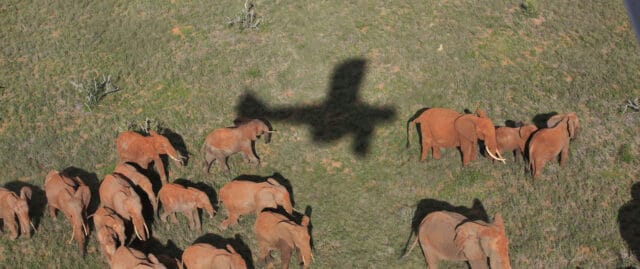
All photographs courtesy of the Sheldrick Wildlife Trust
Even on a dusty airstrip, standing in the heart of Tsavo, it is almost impossible to comprehend the vastness of the wilderness around you. It is famous for being Kenya’s largest national park, but even that qualification doesn’t properly sum up its enormity.
The iconic hulking Yatta Plateau, which dominates Tsavo East, reminds us just how small we are amidst this landscape. But even more poignant reminders come in more subtle forms: its red earth, giant baobabs, doum palm-fringed rivers and luggas, and the grey, angular form of Tsavo’s commiphora woodland. Sunrise comes in brilliant, unearthly hues; at night, millions of stars sweep across the inky, cavernous sky above.
This creates a significant conservation challenge. There are all sorts of vital tasks that, if undertaken from the ground alone, become nearly impossible — and certainly less effective. Locating an orphaned elephant, for instance, is like searching for a needle in a haystack. I would like to share how we tackle this formidable landscape through a bird’s eye approach. Our aircraft are absolutely vital tools in our conservation arsenal as we support the Kenya Wildlife Service. They enable us to rescue orphans, patrol and protect vast swathes of wilderness, mitigate human-wildlife conflict, respond to veterinary cases and other emergencies, medevac injured personnel, extinguish bushfires… the list goes on and on.
– Angela Sheldrick
Wings for Wildlife
The sounds of a Super Cub flying low and slow — to me, these are the sounds of conservation at work. My father, David Sheldrick, was an early proponent of using aircraft for conservation. His wings of choice came in the form of the Super Cub, a versatile plane that is perfectly at home patrolling the bush. David was famously adept at landing it in remarkably difficult conditions, often on dusty tracks or river sandbanks to meet with his teams in situ.
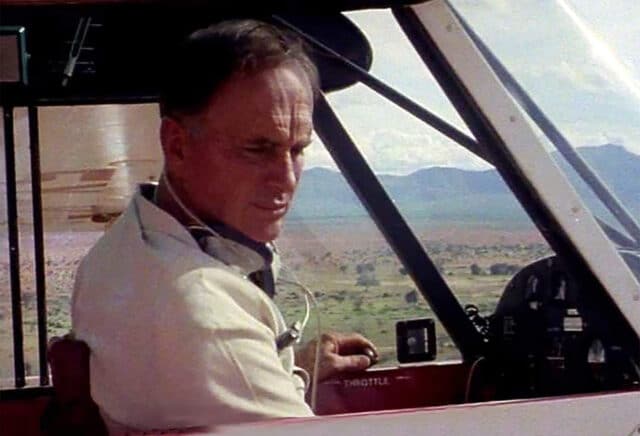
I remember David flying on patrol, slowing the Super Cub to a near-hover to communicate with his rangers on the ground, no different than as if he was talking to them from the driver’s seat of a Land Cruiser! This showed that, in the hands of an experienced pilot, there is little the Super Cub cannot do. It is certainly the ideal tool for a National Park the size of Tsavo. As a child, I spent endless happy hours on Tsavo’s dusty airstrips, waiting for my father’s return and longing for all the stories from the day — because in Tsavo, no day is ever dull.

And so, it was only fitting that a Super Cub would serve as the inaugural aircraft in our fleet, launching the Trust’s Aerial Surveillance Unit in 2008. I can honestly say that this was the single greatest turning point in our operations, quite literally elevating our capabilities for conservation. Suddenly, we had all of Tsavo not only within our view, but also within our reach. Aircraft enhance our work in the most perfect way, complementing the forensic approach of our ground teams with broader capabilities that can only be achieved in the sky. Pilots can cover an area in a fraction of the time it would take on the ground. Crucially, they can also land in areas that are inaccessible for vehicles — of which there are many in this wild landscape.
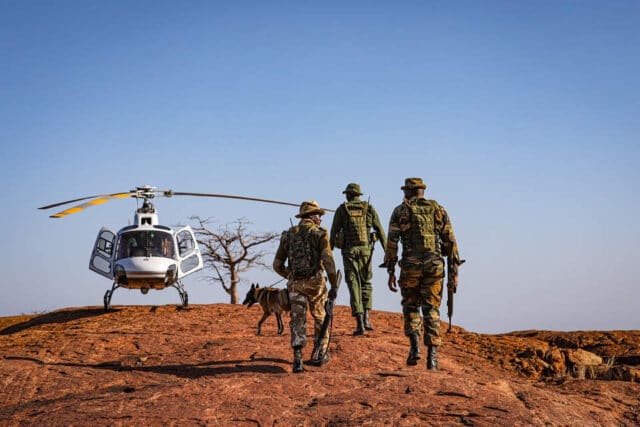
It has been more than a decade since we got our first Super Cub. Our fleet has expanded to seven fixed-wing airplanes and two helicopters, each of which plays a unique supporting role in our work. One of our newest additions, a Baby Caravan STW, is already proving its mettle. As our largest airplane yet, it can safely fly in most weather conditions, undertake night operations, and has the capacity to carry up to ten passengers — or a large elephant calf. In fact, it has already played a vital role in rescuing orphaned elephants and a baby rhino (which sadly succumbed to its injuries the following day). It has been pivotal in numerous veterinary treatments, transporting our teams directly to the patient’s side, and also in deploying Anti-Poaching Teams and the Canine Unit.

If planes are the workhorses, helicopters are the thoroughbreds. Getting our first helicopter was a game-changer. Its versatility is unparalleled: In anti-poaching operations, it drops our sniffer dogs and handlers at the most remote sites. In human-wildlife conflict operations, it shepherds wildlife back into parks and reserves. During firefighting efforts — of which there were 81 last year — it drops water on fires with a Bambi Bucket. For our veterinarians, it provides a perfect platform to dart injured wildlife from the air.
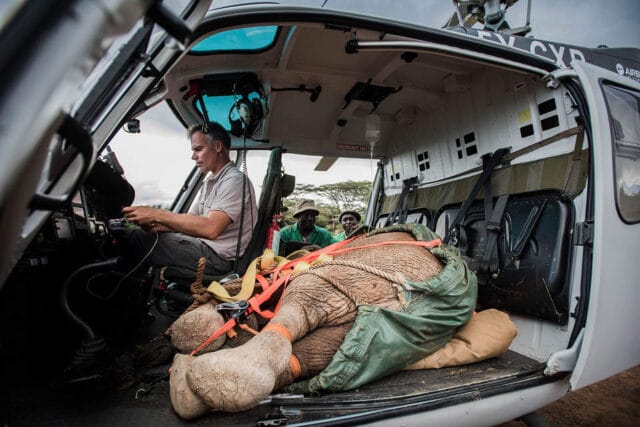
It has even played a starring role in rescuing and transporting orphaned wildlife. (The rescue of Apollo stands out as one of its most memorable missions: Not only was it an extremely challenging operation, but transporting a small but very spirited rhino by air made for quite a harrowing ride! Fortunately, our pilots and Keepers have nerves of steel.)
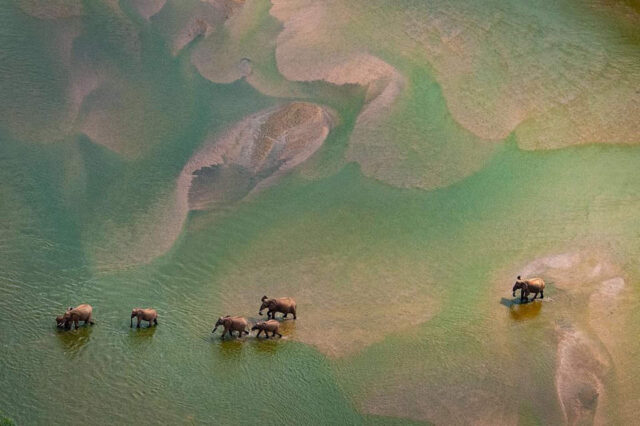
Helicopters and airplanes are only as good as the pilots at their helm. Our pilots are world-class, with exceptional bush prowess. They can navigate Tsavo’s tempestuous winds, shepherd a herd of marauding elephants back to safety, pick out a poacher’s hideout amidst the undergrowth, or even track an orphaned elephant’s tiny footprints along a sandy riverbank. To my immense pride, David’s grandsons, Neville Sheldrick, Taru Carr-Hartley, and Roan Carr-Hartley — Taru and Roan are my sons — are accomplished pilots now, flying both fixed wing aircraft and helicopters in the same wilderness their grandfather patrolled more than half a century ago.
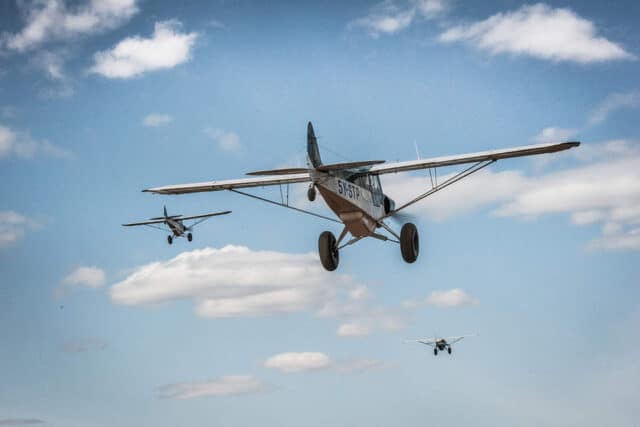
Equally important is the team who keeps our aircraft in flight. Our incredibly talented engineers know every inch of these machines, inside and out. In our line of work, every day comes with unforeseen assignments and emergencies. It is our engineers based in Kaluku who ensure that our aircraft are always ready for their next mission. Our operations room, meanwhile, is the vital link between ground and air. They liaise between all the key players, be it organising a veterinary treatment or connecting the dots for an anti-poaching operation.
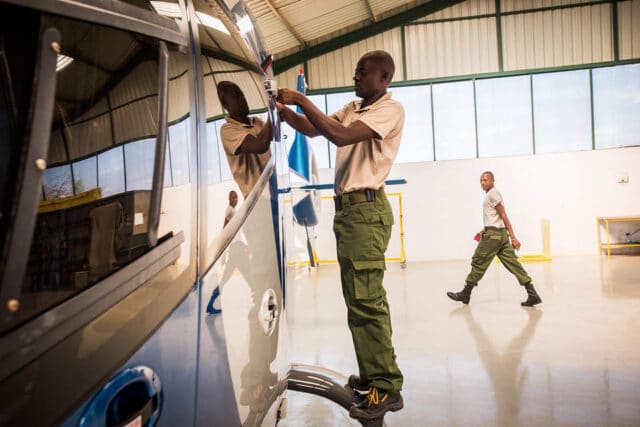
There’s a reason I always wanted to hang out on the airstrip as a child: It really is where all the action happens. The Kaluku airstrip is always alive with activity, even when planes aren’t coming and going. It has become a favourite haunt of our orphans: Apollo uses it as his own personal racetrack, while our motley crew of hooved orphans prefer to stroll up and down its length. Even local wildlife have adopted the Kaluku airstrip as a trusted thoroughfare. Just the other week, an elephant mum and her newborn baby walked by the hangar, followed by a much larger herd the following day. On both occasions, our engineers were mere steps away, working on the aircraft that take flight every day to secure the Tsavo Conservation Area.
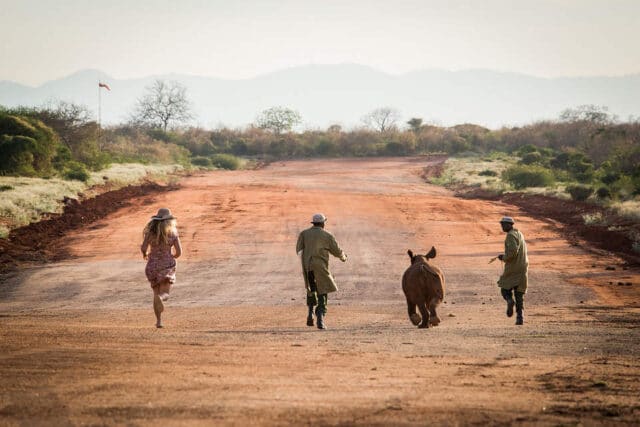
The rescue of Kerrio, the newest addition to the Nursery, shows what a world of difference an aircraft can make. It was an incredibly challenging operation to begin with, set against the backdrop of the warring Pokot and Marakwet tribes. Gunfire had broken out in the night, and by morning, a tiny elephant calf was left behind in the panic. KWS had sheltered her in the relative safety of a nearby school, but we knew this was a rescue without a moment to spare. Navigating thunderous storms, the helicopter made the turbulent journey north. No sooner had it touched down onsite than the elephant was loaded inside, hooked up to an IV drip, and back on her way to the sanctuary of our Nairobi Nursery. Without these aerial capabilities, Kerrio’s rescue would have been simply impossible: Chesogon is a very remote corner of Kenya, and such a vulnerable orphan would have never survived such a demanding journey by road. She is alive today because of that helicopter we were able to charter, given that this rescue happened at the opposite end of the country to our Tsavo operations.

The value our Aerial Unit brings to the table is priceless. It is quantified, to me, by every life saved: orphans we were miraculously able to locate and rescue from this vast wilderness, veterinary cases we could rapidly respond to which would otherwise prove impossible to treat, roaming elephants we were able to spare from human-wildlife conflict, untold numbers of wildlife threatened by bushfires we managed to extinguish, even gravely injured rangers who are we were able to transport to hospital. These individual stories tell a much larger tale, one of how success in the sky translates to extraordinary impact on the ground.
I hope you enjoyed this piece by Angela Sheldrick as much as I did. And if you are searching for a Christmas gift for the person who has everything, then I can highly recommend adopting an orphan from the Sheldrick Wildlife Trust, not just to support the trust but because finding the wonderfully written updates in my inbox truly makes me smile.








I absolutely LOVE this article. Told in simple words, it is a story of people who care more for the environment, for nature, than for a career that has the potential of making them rich – rich in the sense of the accumulation of monetary wealth.
Instead, they are rich because of the rewards, the satisfaction of what they are doing: contributing to the preservation of their environment.
And for me it has the added memories. Okay, I never flew in Kenya but I got my PPL in Africa. More the tropical rain forest area of Nigeria, but I have flown to more savannah- and desert parts as well.
My first commercial flying was on Super Cubs, and I am well familiar with the outstanding versatility of that tiny aircraft. It is very stable and an experienced pilot can do things with the Super Cub that are not in the manuals. We could land, and take-off, in about 50 metres and I have hovered in Cubs as well.
I notice that the PA 18s in the photos were equipped with the oversized “bush” wheels.
Yes, a great pleasure to read this article. Thanks.
Great article and wonderful photos. Thanks for posting it, Sylvia. I will definitely look into gifts from the Sheldrick Wildlife Centre. I love all animals and wish the poachers and murderers could be eradicated.